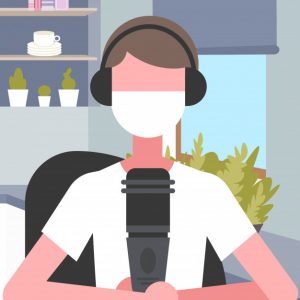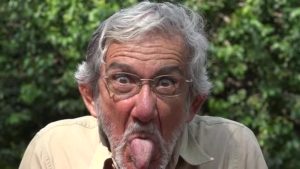Today’s blog is the first in a series where I reached out to some of the most recognizable VO thought leaders to gather a 360-degree view of the voiceover industry as we approach the home stretch of 2020. In this year that has changed so much, I wanted to take a deep dive into as many corners of the business as possible, to see how different parts of VO are responding to the COVID-19 pandemic, and where work has slowed, remained steady, and grown as a result.
Below you’ll find contributions from VO thought leaders Joe Cipriano, Carrie Olsen, and Dave Walsh, each discussing their primary areas of expertise. I’ll be back at the end to add a few words. It’s a long read, but an enlightening one, and should leave us all with a sense of hope in a time of much darkness.
JOE CIPRIANO (Joe Cipriano is best known as the promo voice of the Fox, CBS and NBC Networks. He’s been the live announcer for the Grammy Awards, Primetime Emmy Awards and some of TV’s biggest events. Joe is the recipient of the Don LaFontaine Legacy Award and co-founder of the Don LaFontaine Voice Over Lab at the SAG/AFTRA Foundation in Hollywood.)
JMC: How has the pandemic impacted Promo voiceover? What is the current state of play?
JOE: The “norm” for voicing promos for the past decade has been for talent to record from their
home studios, via SourceConnect, ISDN or iPDTL, for live recording and MP3 for “record on your own”
sessions. It’s very rare that we would actually “go in” to the network, vendor or studio to voice
promos anymore. So, “work from home” is something we’ve perfected and carried out for
years.
As we’ve all experienced the past 5 months, there has been a LOT of television, on-demand and
movie viewing going on as we all hunkered down in our homes looking for entertainment. That
required a lot of content from the providers and a lot of promotion to attract and educate the
viewers, which means a lot of promos. So, while production of NEW shows is non-existent, the
networks and suppliers still need to get the word out to entice the viewer to tune in. Because
of that, there has been a lot of work for voicing promos during the pandemic shutdown.
JMC: What can talent be doing right now to prepare themselves for the post-pandemic
Promo world?
JOE: I’ve said it many times, but this business is ALL about relationships. So, what we all should have
been doing during the shutdown and what we should ramp up as we start to come out of this
period, is to keep in touch with our buyers. It’s important to stay “top of mind” with the people
you have worked with in the past, and to have an effective outreach for new business. I think
it’s important now more than ever because we’ve all been disconnected from one another.
Reconnect. Resume. Reach Out. Repeat and Repeat.
JMC: What long term changes can we expect in Promo as a result of the current crisis?
JOE: I think the changes actually started a few years ago. With more and more content from the
streamers and on-demands resonating with mass audiences, the old model of network, cable
promos is changing. With broadcast networks steadily losing audiences, they are also losing the
platform they use to promote their shows. It doesn’t do you a lot of good to run promos for
new shows on the network when there are not as many eyes watching the network. It’s a
challenge. It used to be so easy to launch new shows with promos that ran during your hottest
programming. You had a built-in, huge audience to “sell” to.
The traditional tag line that might say, “Name of Show” Wednesday at 9, 8 Central on “Network
Name” doesn’t work anymore. Who the heck tunes in to see a show at a specific day and time.
Those days are gone, yet the networks still are clinging to it. Every traditional broadcast
network now has an online presence or streaming app for their content. So, I see the model for
promoting their shows changing. I think there will be more pre-rolls, a lot more social media
promotion for shows. My son is a social media marketing specialist for content, both network,
streaming and movies, and the creative ways they promote and engage viewers across all social
platforms is remarkable. Their strategy and pitch meetings are impressive and innovative.
Social has become and is increasingly the best way to promote and engage the general audience. I think voiceovers can be used in that medium and I’m sure there will be new ideas on the horizon for that. But for the time being we’ll still voice promos for network and cable
outlets (HGTV, Food Network, AMC, FX etc) in a more traditional 30, 20, 10 second format to be
used on-air and online. The change has been rapid and I think the lockdown accelerated new
ideas and new ways to engage viewers and promote content. It’s going to be exciting. If you
want to be a part of it, you have to read the trades. Keep up on what’s new, who the players
are and as always, be a student of the genre.
CARRIE OLSEN (As an e-learning designer, Carrie Olsen developed and subsequently narrated corporate online courses. When she discovered voiceover as an industry, she jumped in with both feet, quitting her job to do voiceover full-time. She began what she calls a ferocious e-learning narration marketing effort that eventually became the blueprint for her course for voice actors: Book More E-learning with Gusto and Elegance. She has since made a home in the voiceover world, partnering with REI, Home Chef, Dreamworks, Netflix, AT&T, TNT, Disney Plus and most recently HBO Max for commercial, e-learning, and promo work. She is committed to sharing her journey with others and now funnels her e-learning and entrepreneurial expertise into her online courses, blog, and Facebook groups. If you want to see her light up, start talking about your dreams. She loves to help people expand their view of what’s possible.)
JMC: How has the pandemic impacted E-Learning voiceover. What is the current state of play?
CARRIE: In the last few months, we’ve seen services that have been almost exclusively delivered in-person (for example, martial arts, religious services, and even summer camps) shift to virtual. Many of these industries were forced to innovate on the fly to stay afloat. Fortunately for the corporate education industry, the blueprint was already there: In 2017, 77% of US companies were already using e-learning.
When we think of e-learning, we usually think of corporate training delivered online. However, e-learning has always been a far-reaching term, applying to corporations, schools, self-improvement, and even purely recreational industries. Since the pandemic these other, less common types of e-learning are starting to take up more space, with more schools and entrepreneurs moving more training content online.
And there are ripple effects. With so many working to adapt their current model to a more remote model, cybersecurity and other online support industries are preparing for an uptick in the demand for their services.
How does all this affect e-learning voiceover? In a general sense, the e-learning industry is growing, so it seems to follow that there will be growing demand for e-learning courses to be narrated, which translates to more job opportunities for voiceover talent.
This sounds like a good thing for voice talent, however, you must keep in mind that while some companies have sustained, or even thrived throughout this crisis, others have experienced budget cuts, layoffs, and even closures. So while we will continue to see more remote work opportunities and training moved online, many companies are being forced to wait out economic difficulties or even cancel e-learning projects they had planned for this year.
Depending on who your clients are, you may be overbooked with e-learning narration work right now, or your work may have all but stalled out.
The good news for e-learning narrators is that regardless of how they are currently weathering the storm, every company has had to take a hard look at how they will deliver training now and into the future. According to elearningindustry.com, most executives are already greenlighting e-learning in their organizations. So we will definitely see the demand for e-learning overall continue to grow in the coming years.
JMC: What can talent be doing right now to prepare themselves for the post-pandemic E-Learning world?
CARRIE: Companies have a lot of options when considering voiceover talent, so don’t wait for the work to come to you. Research the industries you are uniquely suited to partner with, and reach out to them.
Some Basics:
-
Have a great e-learning demo
-
Be proactive with getting referrals
-
On your website, call out to companies who may be moving their content online and share how you can help them
-
Have a great value proposition
-
Develop relationships with e-learning developers and freelance instructional designers
-
As you seek to connect with potential clients, be sensitive to their situation
-
Have standards and workflows in place so that you can most effectively and efficiently serve your clients
-
As always, do good work
JMC: What long term changes can we expect in E-Learning and the industry in general as a result of the current crisis?
CARRIE: Many companies that would have never considered moving their offerings online have now discovered ways to do so. We’re going to see a lot more innovation in the way things are taught and even how school/training is defined.
Long-term, we can expect to see more creativity in the way e-learning is delivered. We’ll see more interactivity in online courses and virtual conferences as presenters and teachers seek to keep attendees’ and learners’ attention.
In the coming months and years, we’ll see more small and large businesses moving their training online. The demand for instructional designers will increase. Voice actors who are proactive and prepared will have more opportunities to partner with clients in need of e-learning narration work.
DAVE WALSH (TrueTell™ founder Dave Walsh has enjoyed a truly multi-faceted career on both sides of the Hollywood glass, as successful artist, coach and director as well as studio executive. Walsh has been a key national and international voiceover talent for almost 20 years, fronting signature campaigns for commercial and television icons including AT&T, HBO, Honda, Entertainment Tonight (ET), Modern Marvels, Shell, NBC’s The Biggest Loser, Wells Fargo, The E! True Hollywood Story, CBS’ Big Brother and Hyundai. Dave has also spent the better part of the last decade coaching and cultivating the voiceover careers of some of the most established artists in the United States, Canada and Latin America.)
JMC: How has the pandemic impacted Commercial voiceover. What is the current state of play?
DAVE: Since March of 2020, the coronavirus pandemic has greatly impacted the commercial voiceover industry in many unforeseen ways.
We all remember that first general sense of panic which took hold in mid March, as country after country began shutting down. In The United States, a few major talent agencies closed their voiceover departments entirely overnight, leaving performers scrambling to find other representation. In those first few weeks, a sense of malaise, dread and fear fell over the industry. Questions abounded: “What do you think will happen?” “Are we next?” “Is the industry over?”
Well, the irony is that the commercial voiceover industry adjusted to these changing times and challenges in ways we could not have imagined. It has been hard for ALL of us, no doubt. But voiceover has proliferated while other parts of the entertainment industry have come crashing to a hault. VO performers with broadcast quality home studios continued on with business as usual while those who didn’t quickly learned that it would be their only means of survival for the foreseeable (and probably long-term) future.
But nowhere have I seen a greater, more swift evolution in the commercial industry than in the voiceover read itself. Over the past five to six months, I have frequently commented on and seen a dramatic shift in script specs. Reads in March and April were what we termed, “The Covid Read” – compassionate, sympathetic, a “we’re all in this together” type of feel. By early May, that read shifted into more of a hopeful, wishful, positive one, mixed with an underline of compassion. Then, within the United States, fueled in part by the federal government’s push to reopen the country’s business and financial centers, a new read surfaced. It was what I call the “Business As Usual” read. Then, soon after the reopen, when some in the U.S. realized the opening was too much, too fast, there was a slight pendulum shift backward toward the more Compassionate read. But this time, it was fueled by the mantra of mask wearing versus the stay-at-home edict from several months prior.
Now, we find ourselves at the forefront a new read once again.
It’s what I call The Permissive Read.
The Permissive Read is fueled by a subtext of giving the consumer the permission and comfort of a guilt-free decision to do things they haven’t done since the dawn of Covid – particularly buy or rent a car and travel. Kia Motors, Jeep, Enterprise Rent A Car and Southwest Airlines are four examples of major brands capitalizing on this direction.
This compilation of performance styles is the swiftest and most comprehensive shift in commercial advertising I have seen and heard in the 30 years that I’ve been a voice actor and coach. And, as we move closer to a vaccine and continue to feel the push/pull of opening businesses and schools versus the fear of contagion, our commercial industry will continue to be in flux. It is therefore crucial for actors to stay vigilant and on their game and to keep abreast of the daily changes in news and the culture. For it is from there that the next read change will evolve.
JMC: What can talent be doing right now to prepare themselves for the post-pandemic Commercial world?
DAVE: To prepare themselves for a post-pandemic commercial voiceover marketplace, it is imperative that actors spend time now researching and strategizing their approach. That includes: 1). Making sure their marketing materials are at the top of the game. 2.) If they haven’t already, invest in broadcast-quality home studio upgrades. 3. Finally and most importantly, take risks and get curious of how to improve performance skills and evolutions.
A key area gravely overlooked by many is the strengthening of self marketing and the relationships with agents and/or future representatives. With regard to self marketing, I would highly suggest reaching out to VO marketing gurus such as Marc Scott of VOPreneur or Anne Ganguzza of VOPeeps to learn how to effectively upgrade their own promotion and marketing platforms. Also, find creative ways to stay (respectfully) top of mind with your reps.
With regard to performance and demos, actors should employ coaches and/or demo producers to maximize the effectiveness of their marketing materials. While, in some agent circles, demos are not used as often as the key driver of auditions or bookings, in the self-marketing world, they are a major force of promotion and visibility. So, whether an agency client, self-marketing actor/entrepreneur or both, these materials should be at their best.
Also keep in mind that in a post-pandemic world, clients, vendors and agents will learn and reach for new, cost-effective ways to run their businesses. Most, if not all agencies are being run from home offices at present. Like so many other industries, whether or not some or all of them return to a bricks and mortar homebase remains to be seen. Therefore, actors who record auditions at their reps’ offices may see a drastic shift in that practice, post Covid. The best piece of advice there? Be ready.
JMC: What long term changes can we expect in Commercial VO and the industry in general as a result of the current crisis?
DAVE: In my estimation, the major long-term changes to the commercial voiceover industry post pandemic will center around the continued shift in physical production and the financial adjustments to accommodate for those shifts.
While on camera commercials will resume on-set production as safety protocols and the decline of the spread become more evident, commercial voiceover may see the short-term changes we adapted to become more permanent. For example, at the present time, most, if not all, commercial spots are recorded in home studios or in heavily isolated recording studios that follow extremely strict health guidelines. As such, advertisers and producers are becoming much more used to working with actors in these environments, resulting in a considerable financial savings. This may have a long-term effect on where commercials will be recorded. So, expect for home studios to continue proliferating through the early to mid part of the decade if not longer.
VO Thought Leaders Closing Words
I hope you found these contributions valuable. In the next few weeks I’ll return with another installment featuring Portia Scott of The Coast to Coast Talent Group, Thom Pinto, and Celia Siegel. Stay tuned, and stay safe!










